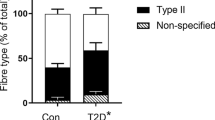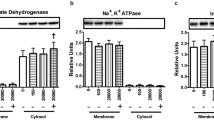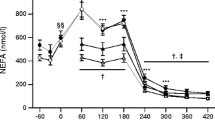Summary
To measure possible changes in basal and insulin-stimulated phosphotyrosine phosphatase (PTPase) activity in skeletal muscle from insulin-resistant individuals, soluble and particulate muscle fractions were prepared from biopsies taken before and after a 3-h hyperinsulinaemic euglycaemic clamp in eight non-insulin-dependent diabetic (NIDDM) patients and nine control subjects. We used a sensitive sandwich-immunofluorescence assay and the human insulin receptor as the substrate. PTPase activity was expressed as percentage of dephosphorylation of phosphotyrosyl-residues in immobilized insulin receptors per 2 h incubation time per 83 µg and 19 µg muscle fraction protein (soluble and particulate fraction, respectively). In the diabetic soluble muscle fractions, the basal PTPase activity was decreased compared with that of control subjects (11.5±5.5 vs 27.5±3.3,p<0.04, mean±SEM). In the particulate muscle fractions from the control subjects, PTPase activity was increased after 3 h hyperinsulinaemia (20.0±3.2 vs 30.2±3.6,p<0.03) and in the corresponding soluble fractions PTPase activity seemed decreased (27.5±3.3 vs 19.9±5.9, NS). No effect of insulin on PTPase activity was found in NIDDM patients (25.1±4.1 vs 27.2±5.2, 11.5±5.5 vs 15.1±4.5 [particulate and soluble fractions], NS). In conclusion, we found that the basal PTPase activity in soluble muscle fractions was decreased in NIDDM patients; furthermore, insulin stimulation was unable to increase PTPase activities in the particulate fractions, as opposed to the effect of insulin in control subjects.
Similar content being viewed by others
Abbreviations
- NIDDM:
-
Non-insulin-dependent diabetes mellitus
- PTPase:
-
phosphotyrosine phosphatase
- OGTT:
-
oral glucose tolerance test
- Hepes:
-
4-(2-hydroxyethyl)-l-piperazineethane sulphonic acid
- PMSF:
-
phenyl methyl sulphonyl-fluoride
References
Bogardus C (1989) Perspective: does insulin resistance primarily affect skeletal muscle? Diabetes Metab Rev 5: 527–528
Olefsky JM (1989) Pathogenesis of non-insulin-dependent diabetes (type II). In: DeGroot LJ, Besser GM, Cahill GF et al. (eds) Endocrinology. Vol 2. WB Saunders Co, Philadelphia, pp 1369–1388
Kolterman OG, Gray RS, Griffin J et al. (1981) Receptor and postreceptor defects contribute to the insulin resistance in noninsulin-dependent diabetes mellitus. J Clin Invest 68: 957–969
Truglia JA, Livingston JN, Lockwood DH (1985) Insulin resistance: receptor and post-binding defects in human obesity and non-insulin-dependent diabetes mellitus. Am J Med 979 [Suppl 2B]: 13–22
Chou CK, Dull TJ, Russell DS et al. (1987) Human insulin receptors mutated at the ATP-binding site lack protein tyrosine kinase activity and fail to mediate postreceptor effects of insulin. J Biol Chem 262: 1842–1847
Lau KHW, Farley JR, Baylink DJ (1989) Phosphotyrosyl protein phosphatases. Biochem J 257: 23–36
Meyerovitch J, Backer JM, Csermely P, Shoelson SE, Kahn CR (1992) Insulin differentially regulates protein phosphotyrosine phosphatase activity in rat hepatoma cells. Biochemistry 31: 10338–10344
McGuire MC, Fields RM, Nyomba BL et al. (1991) Abnormal regulation of protein tyrosine phosphatase activities in skeletal muscle of insulin-resistant humans. Diabetes 40: 939–942
Hauguel-De Mouzon S, Peraldi P, Alengrin F, Van Obberghen E (1993) Alteration of phosphotyrosine phosphatase activity in tissues from diabetic and pregnant rats. Endocrinology 132: 67–74
Olichon-Berthe C, Hauguel-De Mouzon S, Péraldi P, Van Obberghen E, Le Marchand-Brustel Y (1994) Insulin receptor dephosphorylation by phosphotyrosine phosphatases obtained from insulin-resistant obese mice. Diabetologia 37: 56–60
Kusari J, Kenner KA, Suh K-I, Hill DE, Henry RR (1994) Skeletal muscle protein tyrosine phosphatase activity and tyrosine phosphatase 1B protein content are associated with insulin action and resistance. J Clin Invest 93: 1156–1162
Ahmad F, Goldstein BJ (1995) Increased abundance of specific skeletal muscle protein-tyrosine phosphatases in a genetic model of insulin-resistant obesity and diabetes mellitus. Metabolism 44: 1175–1184
Worm D, Handberg A, Hoppe E, Vinten J, Beck-Nielsen H (1996) Decreased skeletal muscle phosphotyrosine phosphatase (PTPase) activity towards insulin receptors in insulin-resistant Zucker rats measured by delayed Europium fluorescence. Diabetologia 39: 142–148
Hashimoto N, Zhang WR, Goldstein BJ (1992) Insulin receptor and epidermal growth factor receptor dephosphorylation by three major rat liver protein-tyrosine phosphatases expressed in a recombinant bacterial system. Biochem J 284: 569–576
Goldstein BJ (1992) Protein-tyrosine phosphatases and the regulation of insulin action. J Cell Biochem 48: 33–42
Report of WHO study group (1985) Diabetes mellitus. Tech Rep Ser 727: 1–113
Hother-Nielsen O, Mengel A, Møller J, Rasmussen O, Schmitz O, Beck-Nielsen H (1992) Assessment of glucose turnover rates in euglycaemic clamp studies using primed-constant [3-3H]-glucose infusion and labelled or unlabelled glucose infusates. Diabet Med 9: 840–849
Lindström TH, Arnqvist HJ, von Schenck HH (1992) Effect of conventional and intensified insulin therapy on free-insulin profiles and glycemic control in NIDDM. Diabetes Care 15: 27–34
Prigent SA, Stanley KK, Siddle K (1990) Identification of epitopes on the human insulin receptor reacting with rabbit polyclonal antisera and mouse monoclonal antibodies. J Biol Chem 265: 9970–9977
Ganderton RH, Stanley KK, Field CE, Coghlan MP, Soos MA, Siddle K (1992) A monoclonal anti-peptide antibody reacting with the insulin receptor β-subunit. Biochem J 288: 195–205
Bradford M (1976) A rapid and sensitive method for the quantitation of microgram quantities of protein utilizing the principle protein dye bonding. Anal Biochem 72: 248–254
Swarup G, Speeg KV, Cohen S, Garbers DL (1982) Phosphotyrosyl-protein phosphatase of TCRC-2 cells. J Biol Chem 257: 7298–7301
Ahmad F, Considine RV, Goldstein BJ (1995) Increased abundance of the receptor-type protein-tyrosine phosphatase LAR accounts for the elevated insulin receptor dephosphorylating activity in adipose tissue of obese human subjects. J Clin Invest 95: 2806–2812
Klip A, Leiter LA (1990) Cellular mechanism of action of metformin. Diabetes Care 13: 696–704
Ahmad F, Li PM, Meyerovitch PM, Goldstein BJ (1995) Osmotic loading of neutralizing antibodies demonstrates a role for protein-tyrosine phosphatase 1B in negative regulation of the insulin action pathway. J Biol Chem 270: 20503–20508
Kulas DT, Zhang WR, Goldstein BJ, Furlanetto RW, Mooney RA (1995) Insulin receptor signaling is augmented by antisense inhibition of the protein tyrosine phosphatase LAR. J Biol Chem 270: 2435–2438
Lammers R, Bossenmaier B, Cool DE et al. (1993) Differential activities of protein tyrosine phosphatases in intact cells. J Biol Chem 268: 22456–22462
Møller NPH, Møller KB, Lammers R et al. (1995) Selective down-regulation of the insulin receptor signal by protein-tyrosine phosphatases α and ε. J Biol Chem 270: 23126–23131
Xiao S, Roses DW, Sasaoka T et al. (1994) Syp (SH-PTP2) is a positive mediator of growth factor-stimulated mitogenic signal transduction. J Biol Chem 269: 21244–21248
Yamauchi K, Milarski KL, Saltiel AR, Pessin JE (1995) Protein-tyrosine-phosphatase SHPTP2 is a required positive effector for insulin downstream signaling. Proc Natl Acad Sci USA 92: 664–668
Milarski KL, Saltiel AR (1994) Expression of catalytically inactive Syp phosphatase in 3T3 cells blocks stimulation of mitogen-activated protein kinase by insulin. J Biol Chem 269: 21239–21243
Vogel W, Lammers R, Jiaoti H, Ullrich A (1993) Activation of a phosphotyrosine phosphatase by tyrosine phosphorylation. Science 259: 1611–1614
Kuhne MR, Zhao Z, Lienhard GE (1995) Evidence against dephophorylation of insulin-elicited phosphotyrosine proteins in vivo by the phosphatase PTP2C. Biochem Biophys Res Comm 211: 190–197
Author information
Authors and Affiliations
Rights and permissions
About this article
Cite this article
Worm, D., Vinten, J., Staehr, P. et al. Altered basal and insulin-stimulated phosphotyrosine phosphatase (PTPase) activity in skeletal muscle from NIDDM patients compared with control subjects. Diabetologia 39, 1208–1214 (1996). https://doi.org/10.1007/BF02658508
Received:
Revised:
Published:
Issue Date:
DOI: https://doi.org/10.1007/BF02658508




